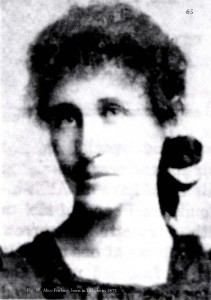Alice Furlong was born on the 17th of January 1871, and spent her childhood at Ferndale in Bohernabreena. Her father James was a well known sports editor with The Irish Independent newspaper and originally came from Co. Wexford. Alice had three sisters, Margaret, Kate and Mary and they were a family who greatly enjoyed both reading and writing poetry. Alice trained to be a nurse at Dr. Steevens’ Hospital and began writing poetry at and early age. Her first poem was published when she was sixteen.

Tallaght was a small and isolated place in those days, so it is not surprising that Katharine Tynan, the poet who lived at Kingswood, knew the Furlong family. In her biography she recalls the autumn of 1888 when she was leaving Tallaght to live in London, “Before going on to the London life, I must speak of my neighbours and friends, the Furlongs, a family consisting of a father, mother and four daughters who lived not far away in a cottage in the Dublin Mountains. Of the four sisters, three wrote poetry. They were wild, leggy young things, with manes of black hair, like mountain ponies, and they were always chattering about poetry and the things that make poetry, at the top of their cheerful young voices”.

In 1899 a London publisher, Elkin Matthews, launched Alice’s first book of poetry titled Roses and Rue and its success established her as one of the best Irish poets of her time.
Alice’s family later moved from Bohernabreena to live in Bawnville House which then stood opposite Ahern’s pub on the Old Bawn Road. She continued to write and became heavily involved in the Irish language movement, the Gaelic League, founded in 1893 by Douglas Hyde and Eoin MacNeill. She is credited with the first translation of Shakespeare’s Macbeth into Irish. Other books were to follow, including Tales of Fairy Folk and Queens and Heroes in 1907.

In 1900 Queen Victoria made an official visit to Dublin, an event which was opposed by various organizations and individuals, including Alice Furlong. During her three week stay, the Queen visited local schools, hospitals and convents and was guest of honour at various banquets. Despite the best efforts of the authorities to attract Dubliners to turn out, they were disappointed that they failed to have any popular demonstration to welcome her. One of the events organized to celebrate the Queen’s stay was a children’s picnic party which took place in the Phoenix Park. Invitations were issued in the Queen’s name to the school children of Ireland, urging them to attend. Free train tickets were given to children in all parts of Ireland, and transport companies offered cheap excursion trips to the Queen’s party.
The business community donated supplies of goods for the picnic party, including 300 gallons of milk from the Lucan Dairy, one ton of biscuits from Jacob and Co., 10,000 bags of sweets donated by Williams and Woods Co., plus a ton of jam and 3,000 buns from the bakers Johnston, Mooney and O’Brien. To the delight of those opposed, the picnic was considered a failure, attended by less than 10,000 but the Lord Mayor of Dublin, Mr. Pile, claimed that “50,000 loyal servants were in attendance”.
In response to this failure, Inghinidhe na hÉireann (The Daughters of Ireland), an organisation made up of female nationalists, founded by Maud Gonne, announced they were “proud of the sturdy resistance of the little Dublin children”, resolved to reward them for their patriotism, and at once organised the Patriotic Children’s Treat. Alice Furlong was a member of Inghinidhe na hÉireann and is credited with the idea of the alternative picnic, which was held on Sunday, 1st July 1900. The event was attended by 30,000 children who marched in procession from Beresford Place to Conturk Park. More than twenty wagons were required to transport the cakes, sweets, fruit and ginger beer to the park, which was, according to Furlong, “distributed free to reward those children who had refused to cheer the English Queen”.
As a result of her involvement with Daughters of Ireland and the Irish language and literary movement Alice Furlong would have known most of the leaders of the Easter Rising of 1916. It is suggested that following the execution of these leaders she became so depressed that she withdrew into seclusion to her home in Tallaght. Kathleen O’Brennan, a journalist and friend of Furlong, wrote the following in 1916, “Having ceased to write in English, she read almost exclusively in Irish, finding this the most satisfying, and she lived with the Gaels. Her love of the language was only shared with her love of Tallaght. To her this little village in the Dublin Hills, and all they recalled, filled her life. She was unhappy away from Tallaght and of recent years looked forward to resting there under the sunshine of the hills. She was an exile away from home, even but a few miles from its beauty.”
There was little doubt that she loved the natural environment of her native Tallaght. At the age of seventy-one, Alice Furlong died. Her funeral took place on 24th October 1946. She was buried in the family plot atTallaght Cemetery (St. Maelruain’s) where a huge crowd was in attendance.
Eamonn Maloney TD.
This post is a synopsis of Eamonn Maloney’s talk to Tallaght Historical Society on 9th March 2012. A version of it also appeared in The Echo on 22nd March 2012.

Alice Furlong was actually born on the 17th January 1871, not 1875.
Thanks for the correction Albert, this has been changed.